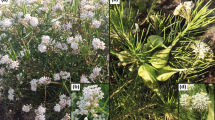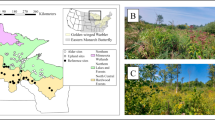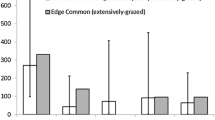Abstract
The population of monarch butterflies east of the Rocky Mountains has noticeably declined over the past two decades. The decline is due, in part, to loss of breeding and forage habitat in the Southern and Midwestern USA. To support a resilient overwintering population of six hectares of occupied forest canopy, approximately 1.6–1.8 billion additional ramets of milkweed are needed in the summer breeding range. Milkweed establishment that facilitates natural behavior of monarchs is necessary for effective conservation restoration. This study explored the effect of milkweed ramet density on larval search behavior, milkweed utilization, and survival without predation, parasitism, or competition. Under our experimental greenhouse conditions, monarch larvae abandoned their natal ramet, and subsequent ramets, prior to the pre-pupal wandering stage and before all available leaf biomass on a ramet was consumed. This is consistent with previous field observations. Larvae consumed biomass from three or four milkweed ramets that totaled the approximate biomass of single 10–35 cm ramet. Movement behavior suggests that isolated ramets may not support development through pupation, even though an isolated ramet could provide enough biomass. Our results suggest milkweed patches containing at least two to four ramets of closely-spaced common milkweed would provide sufficient biomass for development and increase the likelihood that larvae moving in random directions would encounter non-natal ramets to support development. Larval movement behavior and biomass requirements are critical aspects of monarch larval biology that should be considered in habitat restoration and maintenance plans, monitoring survey designs and protocols, and population modeling.






Similar content being viewed by others
References
Agrawal AA (2017) Hatching and defending. Monarchs and milkweed: a migrating butterfly, a poisonous plant, and their remarkable story of coevolution. Princeton University Press, Princeton, pp 90–118
Agrawal AA, Petschenka G, Bingham RA, Weber MG, Rasmann S (2012) Toxic cardenolides: chemical ecology and coevolution of specialized plant-herbivore interactions. New Phytol. https://doi.org/10.1111/j.1469-8137.2011.04049.x
Agrawal AA, Hastings AP, Patrick ET, Knight AC (2014) Specificity of herbivore-induced hormonal signaling and defensive traits of five closely related milkweeds (Asclepias spp.). J Chem Ecol. https://doi.org/10.1007/s10886-014-0449-6
Alijbory Z, Chen MS (2018) Indirect plant defense against insect herbivores: a review. Insect Sci. https://doi.org/10.1111/1744-7917.12436
Bergstrom G, Rothschild M, Groth I, Crighton C (1994/1995) Oviposition by butterflies on young leaves: investigation of leaf volatiles. Chemoecology 5/6: 147–158
Borkin SS (1982) Notes on shifting distribution patterns and survival of immature Danaus plexippus (Lepidoptera: Danaidae) on the food plant Asclepias syriaca. Great Lakes Entomol 15(3):199–206
Brower LP, Taylor OR, Williams EH, Slayback DA, Zubieta RR, Ramirez MI (2012) Decline of monarch butterflies overwintering in Mexico: in the migratory phenomenon at risk? Insect Conserv Divers. https://doi.org/10.1111/j.1752-4598.2011.00142.x
De Anda A, Oberhauser KS (2015) Invertebrate natural enemies and stage-specific mortality rrates of monarch eggs and larvae. In: Oberhauser KS, Nail KR, Altizer S (eds) Monarchs in a changing world. Cornell University Press, New York, pp 60–70
De Moraes CM, Lewis WJ, Pare PW, Alborn HT, Tumlinson JH (1998) Herbivore-infested plants selectively attract parasitoids. Nature 393:570–573
Fischer SJ, Williams EH, Brower LP (2015) Enhancing monarch butterfly reproduction by mowing fields of common milkweed. Am Midl Nat. https://doi.org/10.1674/amid-173-02-229-240.1
Flockhart DT, Pichancourt JB, Norris DR, Martin TG (2015) Unravelling the annual cycle in a migratory animal: breeding-season habitat loss drives population declines of monarch butterflies. J Anim Ecol. https://doi.org/10.1111/1365-2656.12253
Garcia-Serrano E, Reyes JL, Alvarez BXM (2004) Locations and area occupied by monarch butterflies overwintering in Mexico from 1993 to 2002. In: Oberhauser KS, Solensky MJ (eds) The monarch butterfly biology and conservation, 1st edn. Cornell University Press, New York, pp 129–133
Geest EA, Wolfenbarger LL, McCarty JP (2019) Recruitment, survival, and parasitism of monarch butterflies (Danaus plexippus) in milkweed gardens and conservation areas. J Insect Conserv. https://doi.org/10.1007/s10841-018-0102-8
Gershenzon J (2007) Plant volatiles carry both public and private messages. Proc Natl Acad Sci USA 104:5257–5258
Goldstein JA, Mason CE, Pesek J (2010) Dispersal and movement behavior of neonate European corn borer (Lepidoptera: Crambidae) on non-bt and transgenic bt corn. J Econ Entomol. https://doi.org/10.1603/ec09304
Grant TJ, Parry HR, Zalucki MP, Bradbury SP (2018) Predicting monarch butterfly (Danaus plexippus) movement and egg-laying with a spatially-explicit agent-based model: the role of monarch perceptual range and spatial memory. Ecol Modell. https://doi.org/10.1016/j.ecolmodel.2018.02.011
Hartzler RG (2010) Reduction in common milkweed (Asclepias syriaca) occurrence in Iowa cropland from 1999 to 2009. Crop Prot. https://doi.org/10.1016/j.cropro.2010.07.018
Hellman JJ (2002) The effect of an environmental change on mobile butterfly larvae and the nutritional quality of their hosts. J Anim Ecol. https://doi.org/10.1046/j.1365-2656.2002.00658.x
Inamine H, Ellner SP, Springer JP, Agrawal AA (2016) Linking the continental migratory cycle of the monarch butterfly to understand its population decline. Oikos. https://doi.org/10.1111/oik.03196
Jordano D, Gomariz G (1994) Variation in phenology and nutritional quality between host plants and its effect on larval performance in a specialist butterfly, Zerynthis rumina. Entomol Exp Appl. https://doi.org/10.1111/j.1570-7458.1994.tb01794.x
Kellner KF, Swihart RK (2014) Accounting for imperfect detection in ecology: a quantitative review. PLoS ONE. https://doi.org/10.1371/journal.pone.0111436
Malcolm SB (1994) Milkweeds, monarch butterflies and the ecological significance of cardenolides. Chemoecology 5:101–117
Malcolm SB, Zalucki MP (1996) Milkweed latex and cardenolide induction may resolve the lethal plant defence paradox. Entomol Exp Appl 80:193–196
Malcolm SB, Cockrell BJ, Brower LP (1993) Spring recolonization of the eastern North America by the monarch butterfly: successive brood or single sweep migration? In: Malcolm SB, Zalucki MP (eds) Biology and conservation of the monarch butterfly. Natural History Museum of Los Angeles County, Los Angeles, pp 253–267
Nail KR, Stenoien C, Oberhauser KS (2015) Immature monarch survival: effects of site characteristics, density, and time. Ann Entomol Soc Am. https://doi.org/10.1093/aesa/sav047
Oberhauser KS, Anderson M, Anderson S, Caldwell W, De Anda AP, Hunter MD, Kaiser M, Solensky MJ (2015) Lacewings, wasps and flies—oh my: insect enemies take a bite out of monarchs. In: Oberhauser KS, Nail KR, Altizer S (eds) Monarchs in a changing world. Cornell University Press, New York, pp 71–82
Oberhauser KS, Wiederholt R, Diffendorfer JE, Semmens D, Ries L, Thogmartin WE, Lopex-Hoffman L, Semmens B (2017) A trans-national monarch butterfly population model and implications for regional conservation priorities. Ecol Entomol. https://doi.org/10.1111/een.12351
Pannuti LER, Paula-Moraes SV, Hunt TE, Baldin ELL, Dana L, Malaquias JV (2016) Plant-to-plant movement of Striacosta albicosta (Lepidoptera: Noctuidae) and Spodoptera frugiperda (Lepidoptea: Noctuidae) in maize (Zea mays). J Econ Entomol. https://doi.org/10.1093/jee/tow042
Pare PW, Tumlinson JH (1999) Plant volatiles as a defense against insect herbivores. Plant Physiol 121:325–331
Parker CD, Luttrell RG (1999) Interplant movement of Heliothis virescens (Lepidoptera: Noctuidae) larvae in pure and mixed plantings of cotton with and without expression of the Cry1Ac δ-endotoxin protein of Bacillus thuringiensis berliner. J Econ Entomol. https://doi.org/10.1093/jee/92.4.837
Pleasants JM (2017) Milkweed restoration in the Midwest for the monarch butterfly recovery: estimates of milkweeds lost, milkweeds remaining and milkweeds that must be added to increase the monarch population. Insect Conserv Divers. https://doi.org/10.1111/icad.12198
Pleasants JM, Oberhauser KS (2013) Milkweed loss in agriculture fields because of herbicide use: effects on the monarch butterfly population. Insect Conserv Divers. https://doi.org/10.1111/j.1752-4598.2012.00196.x
Price PW, Bouton CE, Gross P, McPheron BA, Thompson JN, Weis AE (1980) Interactions among three trophic levels: Influence of plants on interactions between insect herbivores and natural enemies. Ann Rev Ecol Syst. https://doi.org/10.1146/annurev.es.11.110180.000353
Prysby MD, Oberhauser KS (2004) Temporal and geographic variation in monarch densities: Citizen scientists document monarch population patterns. In: Oberhauser KS, Solensky MJ (eds) The monarch butterfly biology and conservation, 1st edn. Cornell University Press, New York, pp 9–20
Rasband WS (2018) ImageJ, U. S. National Institutes of Health, Bethesda, Maryland, USA, https://imagej.nih.gov/ij/
Rasmann S, Agrawal AA, Cook SC, Erwin AC (2009) Cardenolides, induced responses, and interactions between above- and belowground herbivores of milkweed (Asclepias spp.). Ecology 90:2393–2404
Rawlins JE, Lederhouse RC (1981) Developmental influences of thermal behavior on monarch caterpillars (Danaus plexippus): an adaptation for migration (Lepidoptera: Nymphalidae: Danainae). J Kans Entomol Soc 54:387–408
Razze JM, Mason CE (2012) Dispersal behavior of neonate European corn borer (Lepidoptera: Crambidae) on bt corn. J Econ Entomol. https://doi.org/10.1603/ec11288
Razze JM, Mason CE, Pizzolato TD (2011) Feeding behavior of neonate Ostrinia nubilalis (Lepidoptera: Crambidae) on Cry1Ab bt corn: implications for resistance management. J Econ Entomol. https://doi.org/10.1603/ec10287
RStudio Team (2016) RStudio: Integrated Development for R. RStudio, Inc., Boston, MA https://www.rstudio.com/
Schindelin J, Arganda-Carreras I, Frise E et al (2012) Fiji: an open-source platform for biological-image analysis. Nat Methods 9:676–682
Semmens BX, Semmens DJ, Thogmartin WE et al (2016) Quasi-extinction risk and population targets for the Eastern, migratory population of monarch butterflies (Danaus plexippus). Sci Rep. https://doi.org/10.1038/srep23265
Stamp NE, Bowers MD (1990) Phenology of nutritional differences between new and mature leaves and its effect on caterpillar growth. Ecol Entomol. https://doi.org/10.1111/j.1365-2311.1990.tb00827.x
Thogmartin WE, Lopez-Hoffman L, Rohweder J et al (2017) Restoring monarch butterfly habitat in the Midwestern US: ‘all hands on deck’. Environ Res Lett. https://doi.org/10.1088/1748-9326/aa7637
Truman JW, Riddiford LM (1974) Physiology of insect rhythms III. The temporal organization of the endocrine events underlying pupation of the tobacco hornworm. J Exp Biol 60:371–382
Turlings TCJ, Loughrin JH, McCall PJ, Rose US, Lewis WJ, Tumlinson JH (1995) How caterpillar-damaged plants protect themselves by attracting parasitic wasps. Proc Natl Acad Sci 92:4169–4174
Urquhart FA (1960) The monarch butterfly. University of Toronto Press, Toronto
Urquhart FA (1987) The monarch butterfly: international traveler. Nelson-Hall Inc., Chicago
Van Zandt PA, Agrawal AA (2004) Specificity of induced plant responses to specialist herbivores of the common milkweed Asclepias syriaca. Oikos. https://doi.org/10.1111/j.0030-1299.2004.12964.x
War AR, Paulraj MG, Ahmad T, Buhroo AA et al (2012) Mechanisms of plant defense against insect herbivores. Plant Signal Behav. https://doi.org/10.4161/psb.21663
Zalucki MP, Kitching RL (1982a) Temporal and spatial variation of mortality in field populations of Danaus plexippus L. and D. chrysippus L. larvae (Lepidoptera: Nymphalidae). Oecologia 53:201–207
Zalucki MP, Kitching RL (1982b) Dynamics of oviposition in Danaus plexippus (Insecta: Lepidoptera) on milkweed Asclepias spp. J Zool. https://doi.org/10.1111/j.1469-7998.1982.tb02063.x
Zalucki MP, Kitching RL (1982c) The analysis and description of movement in adult Danaus plexippus L. (Lepidoptera: Danainae). Behaviour 80:174–198
Zalucki MP, Lammers JH (2010) Dispersal and egg shortfall in monarch butterflies: what happens when the matrix is cleaned up? Ecol Entomol. https://doi.org/10.1111/j.1365-2311.2009.01160.x
Zalucki MP, Rochester WA (2004) Spatial and temporal population dynamics of monarchs down-under: lessons for North America. In: Oberhauser KS, Solensky MJ (eds) The monarch butterfly biology and conservation, 1st edn. Cornell University Press, New York, pp 219–228
Zalucki MP, Clarke AR, Malcolm SB (2002) Ecology and behavior of first instar larval Lepidoptera. Annu Rev Entomol. https://doi.org/10.1146/annurev.ento.47.091201.145220
Zalucki MP, Parry HR, Zalucki JM (2016) Movement and egg laying in monarchs: to move or not to move, that is the equation. Austral Ecol. https://doi.org/10.1111/aec.12285
Acknowledgments
This work was supported, in part, by USDA-NRCS/CIG Agreement 69-3A75-16-006 and the Iowa State University, College of Agriculture and Life Sciences. We would like to thank Keith Bidne (USDA, ARS-CICGRU) for maintaining monarch butterfly colonies and providing materials and larvae used in these experiments. We thank Julia Pfeiffer, Signey Hilby, Riley Nylin, Cody Acevedo, Jenna Nixt, and Kara Weber for their help with experimental set up and data collection; without their help twice daily data collection would not have been possible. Additional thanks to ISU Statistics Consulting, Kathleen Rey, Audrey McCombs, and Dr. Philip Dixon. Mention of a proprietary product does not constitute an endorsement or a recommendation for its use by Iowa State University or USDA.
Funding
This work was funded by the Natural Resources Conservation Service (award number 69-3A75-16-006; awarded to Steven P. Bradbury) and by Iowa State University, College of Agriculture and Life Sciences.
Author information
Authors and Affiliations
Corresponding author
Ethics declarations
Conflict of interest
The authors declare that they have no conflict of interest.
Ethical approval
This work is original and has not been submitted to any other journal for consideration. This is a complete study and has not been split into several parts to increase quantity of submissions. Results are presented to the best of our knowledge without fabrication, falsification, or inappropriate data manipulation. No data, text, or theories by others were presented as if they are our own work; proper acknowledgements were given. All work here is well intended. The author list is complete and will not change. Raw data or documents will be provided upon request.
Research involving human and animal participants
This research was not conducted on human subjects and was consistent with the United States Animal Welfare Act.
Additional information
Publisher's Note
Springer Nature remains neutral with regard to jurisdictional claims in published maps and institutional affiliations.
Rights and permissions
About this article
Cite this article
Fisher, K.E., Hellmich, R.L. & Bradbury, S.P. Estimates of common milkweed (Asclepias syriaca) utilization by monarch larvae (Danaus plexippus) and the significance of larval movement. J Insect Conserv 24, 297–307 (2020). https://doi.org/10.1007/s10841-019-00213-2
Received:
Accepted:
Published:
Issue Date:
DOI: https://doi.org/10.1007/s10841-019-00213-2




